WR Size & Red-Zone Efficiency
Rotoworld guest writer Jonathan Bales is the author of the Fantasy Football for Smart People series. He is a regular contributor to the New York Times. Here is a link to the books Bales has written, and here is a link to Bales' new website.
In my view, Peyton Manning is the greatest quarterback in the history of the NFL, and it isn’t even close. The reason I believe that to be the case is because Manning was able to dominate the NFL and win a Super Bowl with the Colts despite a mediocre (at best) supporting cast. Manning’s ability to make those around him look much, much better than they are is unprecedented.
Prior to signing with the Broncos, Manning was particularly deprived of elite wide receiver talent. That’s right, I just said that in Reggie Wayne and Marvin Harrison, Manning was deprived of elite wide receiver talent in Indy. He had two decent receivers, but not a true No. 1.
I used to live right next to Harrison’s uncle when I was located in Philly, and according to him, Harrison was one of the greatest wide receivers of all-time. You can’t really get more biased than an uncle, but a lot of people seem to share that sentiment.
I disagree. Harrison’s numbers were out of this world, but I dare you to find me another dominant 185-pound No. 1 wide receiver. What’s more likely, that Harrison was somehow able to produce at a level no one even close to his size has ever reached mainly because of his own talent, or because he had Manning throw him passes?
I think Wayne might have actually been a better receiver than Harrison, but even he wasn’t a truly elite player. The Fantasy Douche has a nice article on Wayne that shows he’s basically Stevie Johnson:
Reggie Wayne vs. Stevie Johnson
Player | Stevie Johnson | Reggie Wayne |
|---|---|---|
Draft Year | 2008 | 2001 |
40 time | 4.46 | 4.45 |
Weight | 210 | 198 |
Ht | 74 | 72 |
SOS | 6.09 | 5.71 |
School | Kentucky | Miami (FL) |
Drafted by | BUF | IND |
Overall Pick | 224 | 30 |
Share of College Team TDs | 0.28 | 0.26 |
TD/G | 1.00 | 0.91 |
Share of College Team Pass Yds | 0.28 | 0.26 |
Y/G | 80.08 | 68.64 |
Y/R | 17.35 | 17.56 |
Johnson also out-produced Wayne between the ages of 23 and 25 in the NFL. Manning turned a lighter version of Johnson into a potential Hall-of-Famer.
One of the ways you can tell that Harrison and Wayne aren’t nearly as good as their numbers indicate is by looking at their touchdowns. From 1999 to 2006, Harrison scored at least 10 touchdowns in every single season. That’s outrageous. Surely some of that success is because Harrison was a good player, but there’s never been anyone at his size that’s been able to get into the end zone at a rate even close to that.
In believing that Manning is a world-class player—the best passer ever—we don’t need to really buck any sort of historical trends. All of the tools are there. That’s not the case with Harrison (or Wayne), who were clearly the beneficiaries of a quarterback who allowed them to hide obvious physical shortcomings.
Meanwhile, Wayne had the most red zone targets in the NFL from 2000 to 2013 with 201. To give you an idea of how many that is, consider that only three players (Wayne, Terrell Owens and Larry Fitzgerald) had over 170 and only 21 had even half as many as Wayne. That’s what will happen when you’re the No. 1 receiving option on Peyton Manning’s offense.
Wayne’s numbers were drastically inflated because of Manning moving the ball. Even with Manning, though, Wayne recorded just a 22.9 percent red zone touchdown rate. That’s actually slightly below average, which is about what you can expect from a receiver of his stature.
Finding the End Zone: The Importance of Size
Without Manning, Wayne has had some serious trouble getting the ball into the end zone. From 2003 (Wayne’s third season) until 2010 (Manning’s final season with Indy), Wayne scored an average of 8.1 touchdowns per year. In the three seasons after Manning’s final snap as a member of the Colts, Wayne scored 11 total times—3.7 per year.
The Colts should have done a better job of identifying a weakness in their roster that didn’t actually appear to be a weakness because Manning was so good. In 2012 and 2013 as a member of the Broncos, Manning was finally equipped with some big, dominant receivers in Demaryius Thomas and Eric Decker. He proceeded to lead the NFL in completion rate and net-YPA in 2012, then break the NFL records for passing yards and passing touchdowns in 2013. He threw 55 touchdowns at age 37.
Quarterbacks are slow to age, but there’s no way you can tell me that at age 37, after numerous serious neck surgeries, Manning was truly in his career prime. No, he was still playing at a high level, but he was finally given access to receivers with truly elite measurables and skill sets.
If all of that isn’t evidence enough of Manning’s greatness, consider that he made Dallas Clark look great. End of argument.
The idea that the best wide receivers are typically big isn’t new, but I wanted to take some time to analyze wide receivers regarding red zone play. While certain players are more likely than others to score from 50 yards out, the majority of touchdowns come in the red zone, and they’re far, far more consistent.
Although all types of touchdowns are volatile from game to game, there’s a very, very strong long-term correlation between wide receiver size and red zone production. It’s very rare to find a short or light wide receiver who can consistently dominate in the red zone. You might see it over the course of a season or two, but over the long run, it basically ain’t happening unless you have Manning throwing you passes.
Before I get into the numbers, I want to note that because we can use size to predict red zone efficiency so well, it can be really useful for fantasy purposes. As fantasy owners, we want players who are going to score a lot of touchdowns, whether we’re deciding who to draft before the season or who to start in Week 4. We can use size (and college red zone efficiency) to predict that the 6’3”, 220-pound wide receiver who has started his NFL career slowly in terms of touchdowns will probably pick it up, or that the 5’10”, sub-200 second-year receiver who has scored on 35.0 percent of his red zone targets is highly unlikely to maintain that pace.
The Numbers on Red Zone Efficiency
Again, I’m analyzing wide receiver red zone efficiency because we can typically predict red zone production with decent accuracy; offenses will reach the end zone a certain number of times and specific types of receivers will produce at consistent rates.
I took a look at every wide receiver drafted since 2000 to see at least 35 red zone targets. Here’s the percentage of those red zone targets they converted into touchdowns, sorted by height.
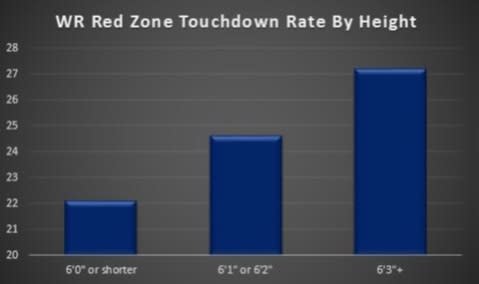
Very obvious relationship between height and red zone efficiency. Overall, wide receivers who stand 6’3” or taller have converted over 27 percent of all red zone targets into scores, compared to 22 percent for receivers 6’0” or shorter - meaning on any given red zone target, a tall receiver is over 20 percent more likely to score than a short one. That’s a significant difference.
The numbers are even more distorted if we sort by weight.
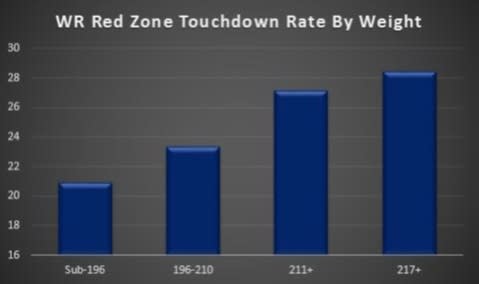
While wide receivers checking in below 196 pounds have converted fewer than 20.9 percent of their red zone targets into touchdowns, those weighing 217 pounds or more have recorded a 28.4 percent red zone touchdown rate. That means the heaviest receivers are 35.9 percent more likely than the lightest receivers to convert a red zone target into a touchdown.
That suggests that weight is a better predictor of wide receiver scoring than height, which is represented in the overall numbers. The strength of the correlation between wide receiver height and red zone efficiency is 0.29. That’s strong, but not nearly as high as the correlation coefficient for weight and red zone efficiency—0.40. Height and weight themselves are of course strongly correlated (0.73), so there’s really good evidence that while height certainly helps pass-catchers in the red zone, weight is more important.
I’m assuming the heaviest receivers are also the best in the red zone because they’re also usually the strongest. Height and leaping ability probably help in certain situations, but wide receivers see far more “regular” targets than jump balls. Because of that—the fact that heavier receivers can shield off defenders and use their bodies to help them make plays on the football—I think we see the numbers come out the way they do.
A Look at the NFL’s Most Efficient Red Zone Wide Receivers
To hammer home this idea, I charted the height and weight of the top 15 most efficient red zone receivers since 2000. First, the height…
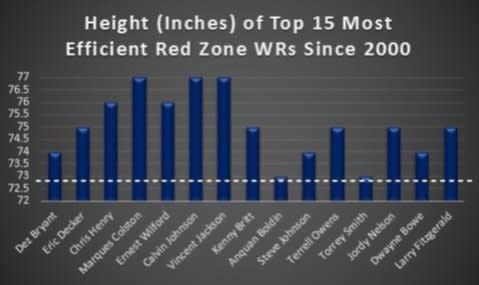
The white dotted line represents the average height for an NFL wide receiver. That means every single one of the 15 most dominant red zone receivers has been taller than average, and most significantly so. Anquan Boldin and Torrey Smith are the only receivers who are near the league average, and only Smith doesn’t have a ton of bulk for his size (he’s about average).
Most of the names on the list aren’t surprising—Dez Bryant, Calvin Johnson, Terrell Owens, Larry Fitzgerald—but there are also some players who weren’t necessarily dominant overall but could still score consistently, such as Chris Henry, Ernest Wilford and Kenny Britt.
Let’s look at weight.
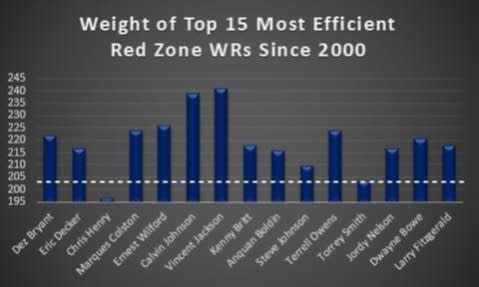
Only one wide receiver—Chris Henry—weighed less than the league average of 203 pounds. Torrey Smith checks in just above that mark, but the rest of the pass-catchers are all significantly heavier. Of the top 15 red zone wide receivers since 2000, 12 have weighed over 215 pounds and seven over 220.
We also see two players in Calvin Johnson and Vincent Jackson approaching tight end territory in terms of size.
How have NFL teams used wide receivers in the red zone?
As usual, we see some inefficiencies in the way NFL teams utilize their players. Overall, they target short, light pass-catchers in the red zone way, way too much. That’s represented in the top 15 wide receivers in red zone targets since 2000.
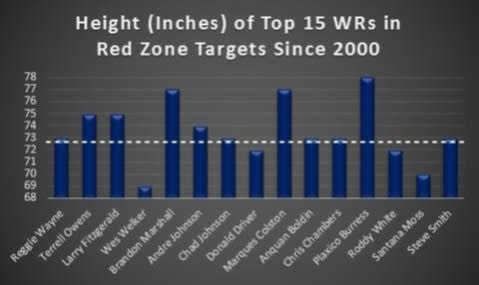
Remember, no wide receiver who ranked in the top 15 in red zone efficiency was below the league average height, and only two were within an inch of it. Meanwhile, of the top 15 wide receivers in red zone targets, four check in below the league average receiver height, and five more are just above it. That’s nine of 15 wide receivers below or near the average height, compared to two in the red zone-dominant group. Quite a difference.
We see a similar effect regarding weight.
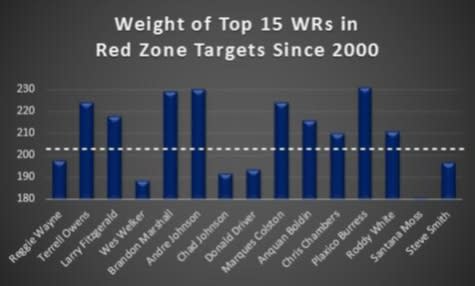
Six of the 15 most-targeted receivers check in well below the league-average weight. When you see a player like Santana Moss ranked in the top 15 in red zone targets, you know there’s a problem. I don’t care how many seasons he’s played; a player of Moss’s stature really shouldn’t even be on the field as his offense approaches the goal line.
Fantasy Implications of WR Red Zone Efficiency
Wide receiver red zone efficiency is very consistent from year to year; for the most part, we see the same types of players atop the list each season. Thus, we can use red zone play to help us target wide receivers with elite upside.
Preferably, we’d like our receivers to be at least 6’2”. If they’re very frail for that height, it might change. If possible, it’s suitable to have wide receivers in the 6’2” range also be bulky, such as Dez Bryant (222 pounds).
Height is good, but weight is even more important. As fantasy owners, we should be targeting wide receivers who can consistently get the ball into the end zone, and heavy receivers are far more likely to do that than light ones. Ideally, you want to target receivers who weigh more than 210 pounds, and preferably closer to 220 (or more).
The numbers should have profound implications on how you draft rookies and other young receivers. Because receivers drafted in the first round of the NFL draft typically cost so much more in dynasty and even redraft fantasy leagues than do second and third-rounders, it can make sense to let other owners overpay for Tavon Austin-type players while you snatch up the Keenan Allen-esque receivers—those with elite size and red zone ability who dropped too far in the NFL draft.
Red zone stats can also help you know when to buy low or sell high on certain receivers. When Percy Harvin had eight total touchdowns in his rookie season, we should have known that, due to his 5’11”, 184-pound frame, that number was probably close to his peak. Harvin had nine total touchdowns in 2011 (only six through the air), but he’s never been able to consistently score. Even in PPR leagues, Harvin has a rather low ceiling because he doesn’t have Dez Bryant/Calvin Johnson/Demaryius Thomas-esque red zone ability. He usually needs to score in unusual ways or do it from far out, both of which are volatile; we might see a 10-touchdown season from Harvin, but we might also see a three-touchdown year from him, even when healthy.
